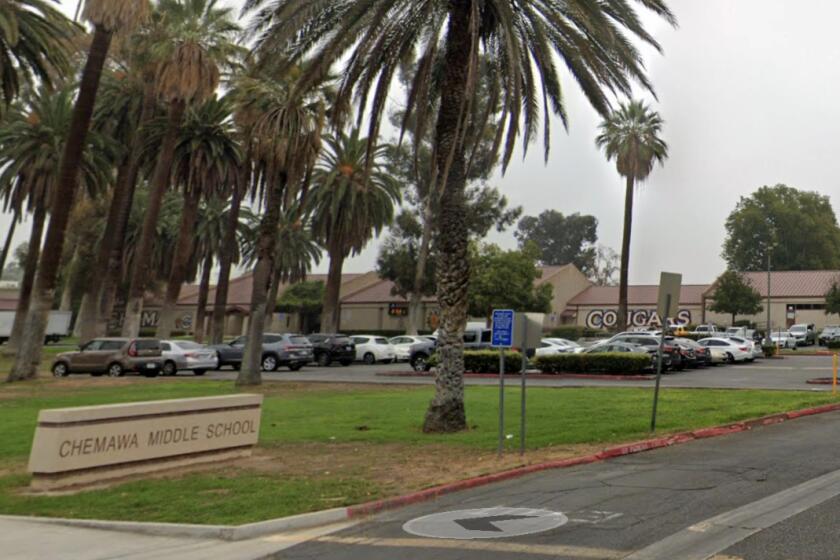LAUSD teachers earn too much to live in the affordable housing apartments built for them

L.A. Unified School District had a teacher turnover problem because of skyrocketing rents.
In the mid-2000s, in the midst of a housing boom, the Los Angeles Unified School District realized that skyrocketing rents were fueling teacher turnover.
Nearly half of all new teachers in some neighborhoods were leaving the district after three years. L.A. Unified was pouring millions of dollars into training new hires, only to watch them pick up and go.
Two below-market apartment complexes were built on unused district land and a third is under construction. Today, both are fully occupied. But not one L.A. Unified teacher lives in them.
That fact alone doesn’t mean L.A. Unified’s affordable housing experiment is a failure.
The projects have created 156 affordable units in Gardena and Hollywood — 121 of which have been rented by L.A. Unified service workers. The apartments designed primarily for middle-class teachers have been an unintentional boon for the cafeteria workers, bus drivers and special education assistants who make up the lowest-paid group in the school system.
The problem for teachers, as district officials learned after they had signed the lease agreements and developers had secured funding, was that even the newest hires earned too much to qualify for the units.
Although the district had used its available land before to build affordable housing in Glassell Park, it had never tried to tailor units to teachers. In attempting to do so, it ran headlong into federal rules that forced developers to set strict income requirements for the apartments.
The starting salary of a new L.A. Unified teacher is a little over $50,300 a year. But the federal subsidies used to build the apartments in Gardena, Hollywood and University Park restricted the units to households that earned 30% to 60% of area median income. In Hollywood, a single person applying for a one-bedroom apartment couldn’t earn more than $34,860.
Mark Hovatter, the district’s chief facilities executive, said the district knew what the eligibility requirements would be. But at the time, he said, district officials thought it possible that a new teacher with a large family and no other source of income would qualify.
In a 2009 report to the school board, optimistic district officials had forecast: “Below-market rate housing targeted to high-turnover staff will reduce turnover and save money.”
But the idea of L.A. public school teachers walking from their doorsteps to their classrooms remained a fantasy.
“It just wasn’t feasible,” said Robin Hughes, president of the nonprofit development company Abode Communities, which built a five-story below-market apartment building over Selma Elementary School’s parking lot. “We ran financial scenarios to see if we could serve entry-level teachers, but we would have lost too much of the public subsidy. There’s no special government funding out there that supports teachers.”
Diamond Jones, 24, a special education assistant at San Pedro High School, was making $15 an hour and living with her parents when she got a letter from the school district advertising the colorful, boxy Sage Park Apartments in Gardena. She had looked for a place of her own and found nothing remotely habitable in her price range.
Jones was one of 7,273 people who applied to live in the 90-unit complex, which has a play area for children, laundry rooms and a community center in which residents can hold birthday parties and baby showers. She was entered into a lottery, which gave preference to school district employees, and emerged a winner.
According to the real estate website Zumper, median rent for a one-bedroom in Los Angeles last month was $1,920. Jones is lucky; she pays $588 a month for hers.
“It’s actually a really nice place,” she said of the sleek, modern apartment complex where the pace of life revolves around the school day. “Everybody has a job and goes to work. There’s not a lot of riffraff.”
Because school support staff typically work part-time jobs and aren’t paid over the summer break, they often struggle to afford housing, said Max Arias, executive director of Service Employees International Union, Local 99, which represents L.A. Unified’s roughly 30,000 service workers. The average cafeteria worker takes home $14,175 a year; a full-time custodian earns an average of $31,152.
Whereas most teachers earn too much to qualify for low-cost housing, falling into what affordable housing advocates call “the missing middle,” many service employees earn too little or have such poor credit that their applications are rejected, Arias said.
“Some of them live in their cars, even while they’re working,” he said. “They find second jobs selling tamales or doing childcare. Their living situations are often pretty bad and they’re constantly facing notices to evict.”
A few of the L.A. Unified service employees who moved into its affordable units previously had been living in homeless shelters with their children district officials said.
Next fall, another 29 affordable units are slated to open near Norwood Elementary School, the final part of the district’s housing push. But whether L.A. Unified will try its hand at affordable housing again remains unclear.
School districts that have successfully built housing for teachers have found ways around relying on federal subsidies, but they’ve had to take an active role in financing the projects and expose themselves to risk.
Santa Clara Unified sold $7 million in bonds, which it will pay back over 30 years with tenants’ rent, to fund its Casa del Maestro project. Built in 2002 and expanded in 2009, the complex offers 70 below-market apartments to teachers.
In San Francisco, where ever-increasing housing costs vastly outpace teachers’ salaries, the school district plans to build a 100-unit housing complex for public school teachers and paraprofessionals, to open in 2020. In the meantime, the district’s 3,300 teachers are struggling and the need for new hires is growing more acute.
Earlier this year, San Francisco Unified began offering $4,000 signing bonuses to special education teachers who agreed to work in the city.
L.A. Unified is leasing the land for the three apartment complexes under 66-year agreements, guaranteeing they will remain below-market for at least that long. Doing so costs the district nothing, officials say, and has so far brought in $315,000 in payments from developers.
“I think board members are interested in the possibility of building more workforce housing,” said school board member Monica Ratliff, who recently suggested the district consider an available 2-acre parcel near Sun Valley High School.
The proposal, however, comes with complications: a nearby charter school has recently expressed interest in using it for archery practice, although archery is not a sport the district recognizes or permits in its schools, and building on it would require neighborhood approval.
Meanwhile, there has been no public discussion of the school district selling bonds to finance low-cost housing that would serve teachers.
“We’re going to consider all the financing models,” L.A. Unified’s Hovatter said. “But we’re not in the affordable-housing business, and I don’t anticipate us getting in.”
Twitter: @annamphillips
MORE EDUCATION NEWS
Yes, an after-school Satan Club could be coming to your kid’s grade school
L.A. Unified decides fate of six charter schools; El Camino leader resigns
Huntington Park leaders voted to ban new charter schools for a year
More to Read
Sign up for Essential California
The most important California stories and recommendations in your inbox every morning.
You may occasionally receive promotional content from the Los Angeles Times.











